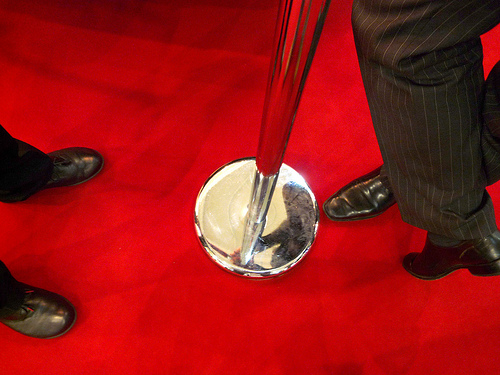
Say you decide to go to a nightclub so you can dance and have a good time.
There are two places to choose from across the street. One’s a bit dingy. The door’s open, but no one’s waiting to get in. The only person standing outside is a seedy-looking promoter yelling at you about a drink special, waving you over like he’s desperate.
The other place?
You see lots of people dancing inside through the floor-to-ceiling windows. There’s a line of well dressed, good looking people waiting outside… and a terrifying looking bouncer with a clipboard in his hand screening who gets in.
Which place would you rather go to?
Most people would choose the club with the line out front – where everyone’s having fun. The line itself makes just getting inside exclusive. The fact that not everyone can get in adds to the appeal.
We see exclusivity in action in all kinds of situations in our daily lives…
But it’s amazing how few businesses apply it in their marketing.
If you’re a freelancer or agency struggling to find more quality clients, keep reading. The solution to your marketing struggles might be as simple as putting out some “velvet ropes.”
The Dangers of Casting Your Net Too Wide
If you’re short on revenue, step one is to get as many new clients as you can. Where they come from isn’t really important… or is it?
This is where a lot of people get into trouble. They stick to the idea that getting clients is “just a numbers game,” so they look for anyone interested in hiring them. They take on all kinds of people and project types.
You’ll land a few gigs with this approach, but not being selective also lets in a lot of low-quality clients. People who won’t commit to a shared vision of success. People who flake on payments, have unreasonable expectations, and don’t trust your judgment.
Casting your net too wide can create a vicious cycle. Work gets frustrating because you spend more time on less than ideal projects for less than ideal pay. You get burned out. And the toll decreases your quality of work for clients you actually like!
A lot of this can be avoided by doing what a lot of people are afraid to do: being intentionally more selective about who you choose to work with.
Making the Most of Your Limited Project Time
As a service provider, you don’t just need more clients. You need more of the right clients – people who will pay the rates you deserve for projects you enjoy working on.
It doesn’t matter if you’re a designer, developer, marketer, or anything else. One thing every service provider has in common: you only have so much time to spend working each day.
Time acts as a natural limitation on your ability to scale your business. Without branching out into other income streams, you can’t expand the same way a product business like a t-shirt company can. They can always buy another press to make more t-shirts.
You can’t clone yourself (yet). Your family and friends miss you. And you need to sleep. This means you have to make the most of your client time to maximize your earning potential.
Casting your net wide might can work when you’re just starting out, but when you’ve been working for a while and want to take things to the next level, there isn’t an easier way to ramp up your income than targeting higher-paying clients.
What If You Made Your Business More Selective?
Photo Credit: eatmorechips
Instead of trying to appeal to everyone, what if you targeted your approach to attract quality clients willing to pay more?
The solution to your marketing dilemma might be doing the exact opposite of what most people do: make it harder to do business with you.
Exclusivity makes people curious and encourages them to act out of the fear of missing out. It makes people curious and taps into the principle of scarcity, one of Robert Cialdini’s key psychological triggers.
We value what’s in short supply. We want something everything can’t have.
When a client hires you and becomes part of an exclusive group, they experience feelings of status and achievement.
The results?
Less stress, more money from each project, and a lot more time to play with. Your marketing becomes less stressful because you don’t need nearly as many leads or sales to do well. Just one or two additional clients can totally change your financial situation.
Exclusivity or “velvet rope” marketing is one of copywriting master Dan Kennedy’s favorite tactics.
But how do you put it into action?
Velvet Rope Marketing in Action
Following the strategies below will help you inject just the right amount of exclusivity to attract premium clients. You’ll screen out the tire kickers, bargain seekers, and clients whose expectations (and budgets) don’t match reality.
Here’s how:
Start with a Quality Offer People Can’t Find Anywhere Else
Photo Credit: Mathieu Thouvenin
People will line up for hours to get their hands on the latest iPhone. Why?
The phone is trendy, looks cool, and owning one gives you a certain amount of status. People want to be part of an exclusive group – one of the first to get their hands on the latest release.
But no one would keep lining up if there weren’t good reasons to want the phone in the first place. It delivers a lot of value for customers through communication, apps, maps, Siri, and so on.
A desirable offer is the foundation for exclusivity. Without that in place, trying to make your services more exclusive won’t do you any good. It would be like the dingy nightclub putting up a bunch of velvet ropes and a bouncer outside without worrying about getting a good DJ and cool dance spot.
So, what makes an offer desirable then?
We can turn to successful high-end retailers for guidance. What do stores like Bloomingdales, Neiman Marcus, and Ralph Lauren have in common?
- High-quality products
- Premium prices
- Something customers can’t find from their competitors
You need these things too. Assuming you have the expertise, you already have the ability to deliver high-quality services and justify premium rates. The last bullet point is tougher: you might have to do some groundwork to express this clearly and separate yourself from competitors.
Do you have a compelling unique selling proposition (USP) in place? That will put you miles ahead of most other people. Chances are you’re already offering something unique – the key is to just get clear about conveying that to your customers.
A proven track record is also key. So you might want to hold off on this velvet rope strategy until you have a portfolio and some solid testimonials to back you up.
Once you have an irresistible offer in place, you’ve given people a reason to want to come inside your “nightclub.”
Give Your Image a Facelift
Photo Credit: gordontarpley
People’s opinion of prices change with the context in which they encounter those prices.
This means that if you can create a better context or experience, you can raise your rates without too many objections.
People are willing to pay more for the same product if it’s in a better context. One study compared people’s sense of price when buying beer at an upscale hotel bar or a rundown grocery store. People actually found it unfair they should pay the same amount at both places – even though the beer was identical.
If you offer exclusive prices in a non-exclusive context, it’s like being the dingy nightclub owner and charging a huge cover free without upgrading the interior, drink menu, and so on. The price is too far out of line with the experience. This creates a lot of pushback from potential clients.
One easy way to give your image an exclusive flair is to update your website design. Does your layout, business name, and even your logo paint a picture of true competence and a quality experience? Those could be ripe areas for a quick image boost.
In his marketing book about selling to the affluent, Dan Kennedy recommends against listing your prices publicly in creative fields to discourage people from shopping based on price. I’ve gone back and forth on this myself. At the very least, it’s something to consider and test!
Another thing to think about is your copy itself. Are you emphasizing benefits that appeal to everyone, or are they specifically targeted to upper-end clients? Here are Dan Kennedy’s emotional drivers that are particularly important to higher-end clients:
- Going backwards (stagnating, losing their money, etc.)
- Fear of being found out as fake
- Fear of being embarrassed socially
- Fear of being out of fashion
- Fear of emotional emptiness (“what’s the point of making all this money if I’m unhappy?”
- Giving themselves “gold stars”
Generally, higher-end clients value time more than anything else. They have big budgets but not the empty calendar space to match. That’s why Kennedy recommends positioning yourself as a competent, efficient provider who can get the job done and make their lives more convenient. Case studies, portfolios, and testimonials can help. This isn’t something you can fake!
Web copy is ripe to be tweaked to emphasize exclusivity language. Buffer compiled a list of 189 words that drive conversions. They identified 12 of those that imply exclusivity. Try to work these into your copy whenever you can.
Use Tiered-Pricing to Create Premium Price Points
Photo Credit: i be GINZ
One of the easiest ways to make your business more exclusive is to offer different pricing tiers.
Depending on what you sell, you might have to get a little creative and bundle related services into different options. But it’s more than worth the effort.
Stratifying your services like this – offering multiple experiences – gives people options. It makes them feel in control of the situation. And it taps into cool pricing psychology hacks like “anchoring,” which makes lower-priced items seem much more affordable in relation to the premium price point.
We’ve found this strategy works great in proposals as well. In our research of over 25,000 proposals, we found that giving prospects one or two more options increased average proposal revenue by 32%!
The highest-priced option is also the most exclusive one. Dan Kennedy estimates that an average of 5% to 20% of clients will choose the highest priced option… just because they want to be part of that select group.
It’s like offering VIP access to your nightclub. Some people don’t just want to get in. They want to parade past everyone waiting in line and flash the bouncer their special badge or wristband. It’s an easy way to make them feel special.
Brainstorm different ways you can offer tiered-pricing. One combination that can work very well: offer only a limited quantity of your premium options. That makes them seem even more exclusive and valuable.
Qualify Your Prospects Before Letting Them Become Clients
Photo Credit: skycaptaintwo
High-quality clients know exactly what they want. They’re willing to invest a little effort up front if that’s what it takes to get it.
Making prospects jump through a few hoops is a great way to send a message of exclusivity. A lot of potential clients will screen themselves out because they won’t be willing to go through them.
But don’t put up hoops just to put up hoops. The goal isn’t to just make people’s lives more inconvenient. The requirements you make people meet before doing business with you should help you learn more about them and provide them with even more value.
What kind of “hoops” are we talking about here? Here are a few ideas to get you started:
- Make people full out a survey or questionnaire before you’ll speak with them.
- Have prospects send over some notes or samples of work to help you get a better idea of what exactly they have in mind (this also forces them to clarify what they really want).
- Explicitly say who you won’t do business with on your website. You could only take on clients in certain industries, or limit your projects to certain scopes or minimum price points.
- Require at least partial payment upfront. This is just good business sense. If a client isn’t willing to do this, count your blessings because you just avoided a flake!
- Have prospects sign contracts with fixed terms to lock in a certain commitment beforehand.
- Start a waiting list. If you don’t have the capacity to take on any more clients right now, you could have prospects sign up for a waiting list. That’s what Ferrari does – one of the most exclusive car brands of all. The average wait time is around 2 years. People reserve cars which haven’t even been produced yet.
Limit Access to Your Services
Photo Credit: mallix
If you’ve followed all the steps so far, you have a really cool “nightclub” with people lining up outside the door. The only thing left to do is put a hulking bouncer out front to limit access. You can’t just let everyone in!
Restricted access is a big part of exclusivity. If Ferrari made as many cars as people who wanted them, owning one would lose a lot of its appeal.
As a service provider, you’re already limited to the clients you can take on because you have to eat, sleep, and do other things besides work. But there are several things you can do to emphasize that natural exclusivity even more:
- Hard limit on the number of clients who get a certain service. This is the most “hardcore” option. You only offer a specific service to a set amount of people, then it isn’t available anymore (though you could get people to sign a waiting list for when a new spot opens up). If you’re going with a hard limit, publicly displaying how many spots remain (once the number is low enough) gets people itching to hire you even more because they don’t want to miss out. Don’t set a hard limit then take on more people than you said you would. That cuts into your credibility.
- Limit services only to clients who meet your requirements. This is the route a lot of service providers go. You’re reasonable and willing to work with people… as long as they make a base investment in the relationship by meeting a set of criteria you define beforehand. This is a good way to make things exclusive without making them too exclusive.
- Time limits. You can always try making limited-time offers about special services, free consultations, and so on. The only caveat: just like with the hard limits, actually end the offer when you say you will. You’ll hurt your credibility if you go back on your word.
- Appearance of exclusivity. You can make some services seem more exclusive (without actually limiting the quantity) just by not promoting them as blatantly as your other services.
Command the Rates You Deserve with Better Positioning
“Velvet rope” marketing might not work for every service in all situations, but it’s definitely worth thinking about.
Most service providers aren’t trying to be the lowest-priced option. It’s hard to run a sustainable business that way. Positioning yourself as an exclusive provider can help you command the rates you deserve and emphasize your unique strengths.
So much of successful marketing comes down to positioning and perception. You’re already offering valuable solutions people can’t find anywhere else – applying the tips above make it easier to convey that to potential clients. Give them a shot!
Have you ever tried to make your business more exclusive? How did you do it, and what were your results? Leave a comment below and let me know!







